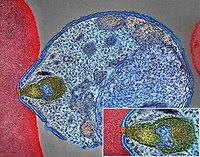
Photo from wikipedia
Malaria is predominant in many subtropical nations with little health-monitoring infrastructure. To forecast malaria and condense the disease’s impact on the population, time series prediction models are necessary. The conventional… Click to show full abstract
Malaria is predominant in many subtropical nations with little health-monitoring infrastructure. To forecast malaria and condense the disease’s impact on the population, time series prediction models are necessary. The conventional technique of detecting malaria disease is for certified technicians to examine blood smears visually for parasite-infected RBC (red blood cells) underneath a microscope. This procedure is ineffective, and the diagnosis depends on the individual performing the test and his/her experience. Automatic image identification systems based on machine learning have previously been used to diagnose malaria blood smears. However, so far, the practical performance has been insufficient. In this paper, we have made a performance analysis of deep learning algorithms in the diagnosis of malaria disease. We have used Neural Network models like CNN, MobileNetV2, and ResNet50 to perform this analysis. The dataset was extracted from the National Institutes of Health (NIH) website and consisted of 27,558 photos, including 13,780 parasitized cell images and 13,778 uninfected cell images. In conclusion, the MobileNetV2 model outperformed by achieving an accuracy rate of 97.06% for better disease detection. Also, other metrics like training and testing loss, precision, recall, fi-score, and ROC curve were calculated to validate the considered models.
Journal Title: Diagnostics
Year Published: 2023
Link to full text (if available)
Share on Social Media: Sign Up to like & get
recommendations!